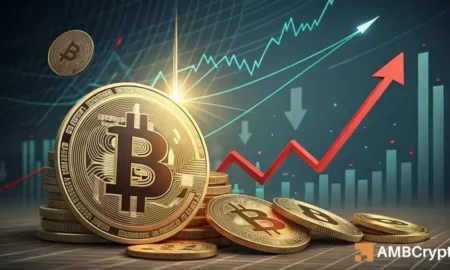Current Trends in Bitcoin (BTC) Market: Analyzing Bear Market Indicators and Whale Activity
The Bitcoin (BTC) network has recently fallen below its yearly moving average, a significant indicator that suggests the onset of bear market conditions. This development raises concerns about the potential hindrance to any anticipated recovery in the BTC price in the near future. The on-chain analyst JA Maartun has observed a notable reduction in BTC network activity, which has dipped below the 365-day moving average. Historically, such subdued activity aligns with bear market trends seen during previous years, including 2018 and 2022, suggesting that unless there is a considerable shift in market sentiment, BTC may struggle to regain momentum.
The yearly moving average is a crucial technical indicator that tracks important network adoption metrics—such as active addresses, block space demand, and transaction counts per block. When network activity languishes at these levels, it often brings price appreciation to a standstill. As experienced in past cycles, a lack of significant adoption and participation tends to cap the potential for upward price movement in BTC. The latest data indicates that such diminishing network adoption can complicate efforts to initiate a robust recovery for Bitcoin in the immediate term.
Despite the bearish readings from the network activity, a deeper examination reveals that a segment of the market is still exhibiting signs of accumulation. Recent reports from crypto analytics platform CryptoQuant have demonstrated notable behavior from Bitcoin whales and miners. Last week, these major investors offloaded a staggering 30,000 BTC—representing nearly $2.5 billion at an average price of $82,000 per BTC. The movement was markedly influenced by the declining profit margins for miners. As profit declines, miners have shown a tendency to liquidate portions of their holdings, with activities reflecting a delicate balance between profit generation and maintaining their assets.
Interestingly, despite the unsettling sell-off, Bitcoin has managed to maintain its value above $80,000 for over a week. Market analyst Eric Balchunas from Bloomberg attributes this price resilience to strong demand from U.S. spot Bitcoin exchange-traded funds (ETFs) and significant purchases by notable players like Michael Saylor. In a disconcerting yet revealing twist, analysts at Glassnode reported that certain whales are continuing to accumulate BTC even amid current price weaknesses. Their data indicates that the Accumulation Trend Score has peaked at 0.34, the highest it has been this year. This score reflects that many wallets are transitioning back into accumulation mode, with significant stakeholders capitalizing on what they perceive to be attractive entry points.
However, it is essential to understand the contrasting sentiments at play in the market. The Coinbase Premium Index, which measures demand dynamics from U.S. retail investors, currently indicates a neutral stance. This balance suggests that retail interest could easily shift toward either buying or selling, which could greatly influence BTC’s future trajectory. A sustained rise in the Coinbase Premium could provide the fuel necessary for a prolonged recovery, enticing more buyers back into the market. Conversely, if the index dips, it may trigger additional selling pressure and potentially push Bitcoin prices lower, exacerbating the existing bear market conditions.
In conclusion, while there are signs of accumulation among key market players, Bitcoin’s overall outlook remains tenuous amidst deteriorating network adoption and bearish indicators. The current landscape is characterized by a complex interplay of whale activities, market sentiment, and retail investor behavior. Observers must remain vigilant to key indicators, particularly the Coinbase Premium Index and network activity, as these will dictate BTC’s ability to rebound from its current state. As we advance, the market’s response to these dynamics will be crucial in determining whether Bitcoin can overturn its bearish tendencies and pave the way for a sustained recovery.
















